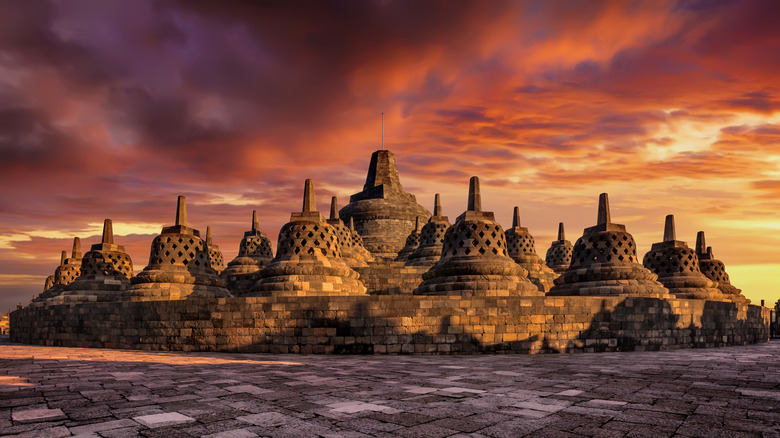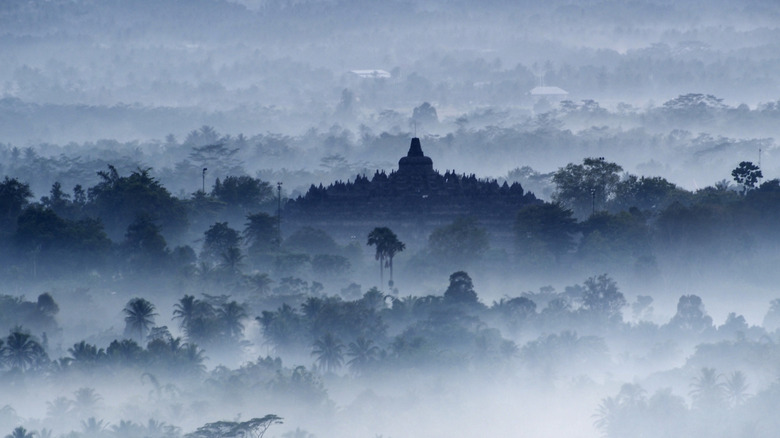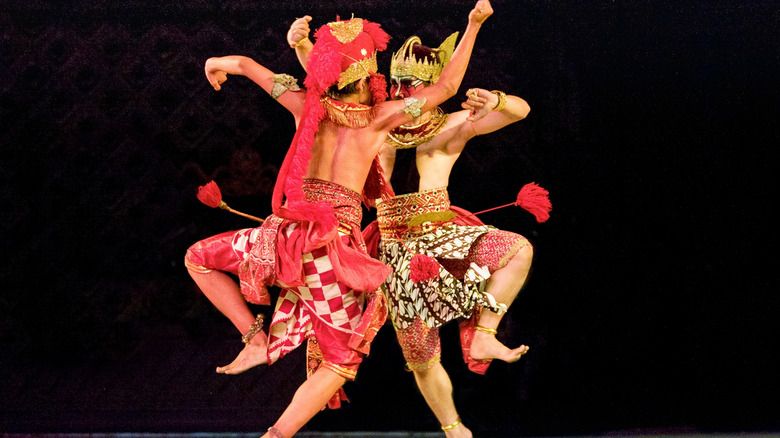The World's Largest Buddhist Monument Is Hidden On A Sacred Indonesian Mountain
When you think of majestic Buddhist temples, images of the golden pagodas of Thailand may come to mind. While these structures are undeniably stunning and of great cultural value, another Buddhist holy place frequently tops lists of the most beautiful temples in the world.
Standing on a hilltop in Central Java, Borobudur rises from the jungle, towering over the emerald rice fields and network of rural roads. At over 1,200 years old, the massive temple has weathered floods, earthquakes, volcanic eruptions, and even a bombing in the 1980s. Although built during the Syailendra dynasty (between the 8th and 9th centuries) and boasting many Indian influences, the pyramid-shaped temple is distinctly Javanese. At 115 feet tall and 387 feet wide, it's the largest Buddhist temple in the world, defined as a single construction instead of a complex like Cambodia's Angkor Wat. While it's possible to experience the entire place in one day, you'll need to conserve your energy.
However, the massive size and lengthy history aren't the only things that make Borobudur one of Indonesia's greatest treasures. The craftsmanship, meticulous symmetry, and sheer engineering have no equal. For instance, the entire structure was built without cement or other mortar plasterings. Instead, builders cut individual stones to size before using dovetail joints to attach slabs and other pieces. In addition, the temple features almost 27,000 square feet of intricate reliefs depicting Buddha's life and teachings, plus 72 stupas with Buddha statues inside.
The best place to watch sunrise and other tips for visiting Borobudur
Picture this: you arrive at Borobudur in the dark, following the glow of flashlights as you scale one of the staircases leading to the structure's highest point. Resting your back against the cool volcanic stones, you watch the sun creep over the horizon, casting a dusty glow over the surrounding mountains and illuminating the low-lying mist. As the sun gains strength, the bell-shaped stupas and Budhha statues transition from vague silhouettes to detailed stonework in a gradient of grey hues.
You can find this panoramic view from the first, second, and third terraces of the temple. However, for the best sunrise views with Borobudur in the distance, head to Punthuk Setumbu. Popular among Indonesian travelers, this viewpoint provides expansive views of Mt. Merapi and Borobudur as the morning mist burns off. Arrive at least half an hour before sunrise to ensure you find a parking space.
If you visit Borobudur during the day, remember that the sun is deceptively strong, and the temple provides little shade. The best time to visit is between sunrise and 10:00 a.m. because the temperature is lower and you can comfortably walk the pilgrim's path. Starting at the eastern stairway, it takes you clockwise along each of the nine levels, passing hundreds of reliefs that represent the path to enlightenment. Also, never sit, lean, or put your feet on the stupas because it's disrespectful to the Buddha statue inside.
Things to do near Borobudur
Many visitors combine a trip to Borobudur with a stop at Prambanan, the largest Hindu temple in Indonesia, dating back to around the 9th century. Reserve a ticket for the Ramayana Prambanan to see over 200 dancers and musicians perform the epic Hindu tale against the backdrop of the Prambanan temple. Due to the stage's open-air construction, performances are only scheduled during the dry season (November through April).
Those visiting either temple will likely stay in Yogyakarta, a city in Central Java known for its art scene and universities. Here, you can learn about batik-dyeing techniques and complete your own projects at Lukman Batik or discover the Javanese art of shadow puppetry at Museum Sonobudoyo. You can't miss shopping for local crafts and snacks along Malioboro Street or trying the best chocolate at Monggo Chocolate Factory — the prices are excellent, and the tour includes free samples.
Want a challenge with a rewarding view? Hiking this Indonesian mountain should be on your bucket list. Situated 10 hours from Borobudur (a short drive considering Java's size), volcanic Mount Ijen features an aquamarine acid lake and vivid blue sulfur flames. Depending on the wind's direction, you may need to wear a guide-provided gas mask for part of the hike. A typical Java itinerary includes a stop at Borobudur and Yogyakarta, followed by a visit to Ijen, and then a stop at Mount Bromo, a volcano ranked one of the most incredible landscapes in the world.


